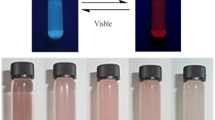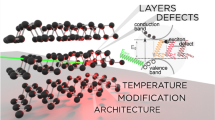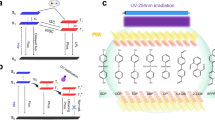Abstract
Fluorescent guest molecules doped in polymers have been used to convert ultraviolet light into visible light for applications ranging from optical fibres to filters for the cultivation of plants. The wavelength conversion process involves the absorption of light at short wavelengths followed by fluorescence emission at a longer wavelength. However, a precise understanding of the light conversion remains unclear. Here we show light responses for a purified polystyrene base substrates doped with fluorescent benzoxanthene in concentrations varied over four orders of magnitude. The shape of the excitation spectrum for fluorescence emission changes significantly with the concentration of the benzoxanthene, indicating formation of a base substrate/fluorescent molecule complex. Furthermore, the wavelength conversion light yield increases in three stages depending on the nature of the complex. These findings identify a mechanism that will have many applications in wavelength conversion materials.
Similar content being viewed by others
Introduction
Due to considerable losses by absorption and reflections, short-wavelength light transmission over long distances in optical fibres is challenging1,2. Moreover, plants do not efficiently utilize short-wavelength sunlight during photosynthesis. To overcome these problems, wavelength conversion materials have been developed. These materials are polymers doped with fluorescent guest molecules that absorb light at shorter wavelengths and re-emit it at longer wavelengths3,4. However, there are aspects of this process that are not fully understood.
Advanced refining techniques enable the production of high purity substrates and the control of fluorescent molecule concentrations in wavelength conversion materials5. Here we characterize in detail the light response for a purified wavelength conversion material by varying the concentration of a fluorescent benzoxanthene derivative in a polystyrene base substrate over four orders of magnitude. Based on the fluorescent spectra and light yields over the large benzoxanthene concentration range, we reveal a complex between the polystyrene and the fluorescent benzoxanthene. The repeat unit for polystyrene and the structure of the benzoxanthene derivative are shown in Fig. 1 and 2, respectively.
Results
Two-dimensional fluorescence spectra for polystyrene samples with various concentrations of benzoxanthene are shown in Fig. 3. Two distributions are observed: one is in the 310-nm region due to the polystyrene and the other is around 465 nm due to the benzoxanthene. Fig. 4 shows the excitation spectrum monitored at 465 nm for each sample. The spectra clearly do not overlap and significantly differ between the 0.02 to 0.2 wt% concentrations of benzoxanthene. These results indicate a possible interaction between the polystyrene and the benzoxanthene. Furthermore, excitation peaks below 350 nm emerge as the benzoxanthene concentration increases.
Two-dimensional fluorescence spectra of polystyrene doped with benzoxanthene.
The concentrations of the benzoxanthene derivatives are (a) 0.0002 wt%, (b) 0.002 wt%, (c) 0.02 wt%, (d)0.05 wt%, (e) 0.1 wt%, (f) 0.2 wt%, (g) 0.5 wt% and (h)1.0 wt%. The 310-nm maximum (peak) in the emission wavelength for the pure, undoped base substrate is denoted by the light blue line in each x-axis.
Fig. 5 shows the emission spectrum due to 425-nm excitation for each sample. We see that UV light is converted to blue-green light by adjusting the fluorescent concentrations. Fig. 6 shows the light yield for each wavelength conversion sample, where the yield for undoped polystyrene base substrate is given by the blue line. The light yield increases in three distinct stages with the benzoxanthene concentration, in an S-shaped curve. The three stages in the light yields can also be seen in Fig. 3. This observation, as with the excitation spectra, indicates that there is an interaction between the polystyrene and the benzoxanthene. The light blue line in each x-axis denotes the 310-nm maximum in the undoped polystyrene emission. The line for the spread of the distribution is the boundary between the first and second stages. When the distribution spreads to 250 nm, there is a shift from the second to the third stage.
These results indicate that the polystyrene and benzoxanthene are not independently excited and de-excited. Instead, complexes develop over three stages depending on the benzoxanthene concentration. At the first stage, the interaction between the polystyrene and the benzoxanthene is weak and each behaves independently. The second stage indicates a definite interaction and a loss of independence. In the third stage, the interaction is strong, the independence is completely lost and there is a possibility of concentration quenching6.
Discussion
The conversion mechanism revealed at wide fluorescent molecule concentrations expands the scope of applications7,8,9,10,11,12,13,14. For example, optical fibres that are used for wavelength conversion have 0.01–0.03 wt% fluorescent doping15. The excitation distribution of the fluorescence now spreads to short wavelength regions (e.g., 250 nm) at those concentrations. When using such fibres, we should therefore take care of both the targeted light (370–480 nm) and short-wavelength light external to the fibres, or the light emitted from the base substrate. On the other hand, the wavelength conversion materials have a great potential to convert internal or external ultraviolet light to visible light by adjusting fluorescent guest molecule concentrations.
In summary, we have characterized polystyrene base substrates doped with the fluorescent benzoxanthene over a wide concentration range. Complexes between the polystyrene and the benzoxanthene emerged, indicating that wavelength conversions have complicated mechanisms.
These findings have a great potential to improve the overall performance of the wavelength conversion materials. It is also important to investigate the wavelength conversion materials formed by other base substrates/fluorescent molecules16,17,18.
Methods
Styrene monomers were refined via reduced-pressure distillation and mixed with different concentrations of benzoxanthene (0, 0.0002, 0.002, 0.02, 0.05, 0.1, 0.2, 0.5, 1.0 wt%). The purity of the benzoxanthene was more than 99.1% and the purity of the polystyrene was more than 99.9%. These solutions were injected through 0.2-μm pore filters into glass reaction vessels and then sealed under vacuum. The solutions were thermally polymerized in an oil bath held first at 100°C and then elevated to 150°C. Colouration brought about by heat deterioration or oxygen contamination was minimized. The average molecular weight of the polystyrene doped with the benzoxanthene was approximately 300,000 at a 99.5% polymerization rate. Each wavelength conversion material was cut into 62 × 62 × 10 mm samples and then polished.
Fluorescence spectra were acquired with a spectrophotometer (F-2700; Hitachi High-Technologies Co., Ltd.). To avoid a bias to the light yield caused by light absorption and emission by the polystyrene and the benzoxanthene, the yields were determined with a 207Bi radioactive source (BIRB4391; High Technology Source Ltd.) and a photomultiplier tube (PMT, R878-SBA; Hamamatsu Photonics Co., Ltd.). Monoenergetic internal conversion electrons from the radioactive source generated light emission in the samples. The PMT had the equivalent quantum efficiency as the two fluorescence regions of the polystyrene and the benzoxanthene. The 62 × 62 mm face of each sample was in contact with the PMT photocathode via optical grease (EJ-550; Eljen Technology) and the radioactive source was placed in the centre of the opposite face.
References
Sun, Z. et al. Nonlinear optics: Fibre sources in the deep ultraviolet. Nature Photonics 5, 446–447 (2011).
Hadifeld, R. H. Single-photon detectors for optical quantum information applications. Nature Photonics 3, 696–704 (2009).
Beringer, J. Particle Data Group. Phys. Rev. D86, 010001 (2012).
Leo, W. R. Techniques for nuclear and particle physics experiments: a how-to approach. 2nd ed., Springer-Verlag, Berlin and Heidelberg (1992).
Nakamura, H. et al. Development of polystyrene-based scintillation materials and its mechanisms. Appl. Phys. Lett. 101, 261110 (2012).
Knoll, G. Radiation detection and measurement. 4th ed., Wiley, New York (2010).
Camanzi, B. & Holms-siedle, A. G. The race for radiation monitors. Nature Materials 7, 343–345 (2008).
Nakamura, H. et al. Radiation measurements with heat-proof polyethylene terephthalate bottles. Proceedings of the Royal Society A 466, 2847–2856 (2010).
Kumar, V. et al. Effect of gamma irradiation on the properties of plastic bottle sheet. Nucl. Instrum. Method Phys. Res. B 287, 10–14 (2012).
Nakamura, H. et al. Senses alone cannot detect different properties. Physics Education (2013) in press.
Sen, I. et al. Polyester composite thermal neutron scintillation films. IEEE Trans. Nucl. Sci. 50(4), 1781–1786 (2012).
Nagata, S. et al. Damage and recovery processes for the luminescence of irradiated PEN films. Nucl. Instrum. Method Phys. Res. B, in press (2013).
Nakamura, H. et al. Blended polyethylene terephthalate and polyethylene naphthalate polymers for scintillation base substrates. Radiation Measurements (2013) in press.
Nagata, S. et al. Recent research activities on functional ceramics for insulator, breeder and optical sensing systems in fusion reactors. Journal of Nuclear Materials (2013) in press.
Hawkes, C. M. et al. Decay time and light yield measurements for plastic scintillating fibres. Nucl. Instrum. Method Phys. Res. A 292(2), 329–336 (1990).
Nakamura, H. et al. Evidence of deep-blue photon emission at high efficiency by common plastic. EPL (Europhysics Letters) 95, 22001 (2011).
Shirakawa, Y. et al. A fast response radiation detector based on a response prediction method for decontamination. Radiation Measurements 49, 115–119 (2013).
Nakamura, H. et al. Optimized mounting of a polyethylene naphthalate scintillation material in a radiation detector. Applied Radiation and Isotopes 80, 84–87 (2013).
Acknowledgements
This work was supported by the Kyoto University Research Reactor Institute, National Institute of Radiological Sciences and Kuraray Co., Ltd. The authors thank the KUR Research Program for Scientific Basis of Nuclear Safety for partial support at this work. The authors are grateful to Dr. T. Murata, Dr. T. Fukunaga, Dr. H. Yamana, Mr. K. Suzuki and Ms. M. Yasaku for their co-operation.
Author information
Authors and Affiliations
Contributions
H.N. planned the research; H.N., Y.S., H.K., N.S. and S.T. performed research; O.S. and K.S. prepared the sample. All authors discussed the results and commented on the manuscript.
Ethics declarations
Competing interests
The authors declare no competing financial interests.
Rights and permissions
This work is licensed under a Creative Commons Attribution 3.0 Unported License. To view a copy of this license, visit http://creativecommons.org/licenses/by/3.0/
About this article
Cite this article
Nakamura, H., Shirakawa, Y., Kitamura, H. et al. Mechanism of wavelength conversion in polystyrene doped with benzoxanthene: emergence of a complex. Sci Rep 3, 2502 (2013). https://doi.org/10.1038/srep02502
Received:
Accepted:
Published:
DOI: https://doi.org/10.1038/srep02502
Comments
By submitting a comment you agree to abide by our Terms and Community Guidelines. If you find something abusive or that does not comply with our terms or guidelines please flag it as inappropriate.









